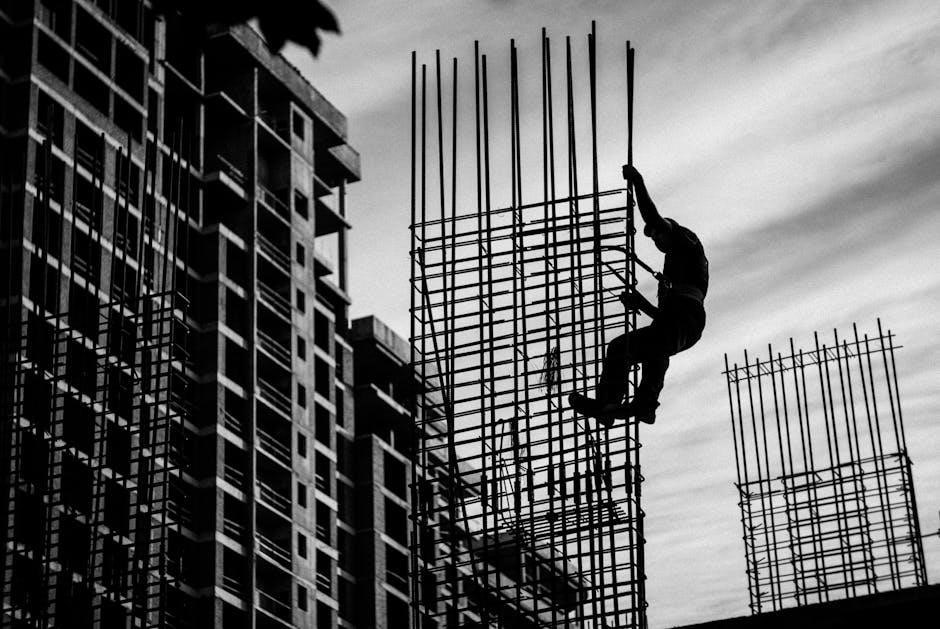The Building Safety Act 2022 is landmark legislation transforming the UK’s approach to building safety, focusing on higher-risk buildings and establishing a new regulatory framework.
1.1 Overview of the Act
The Building Safety Act 2022 introduces a comprehensive framework to enhance safety standards across building design, construction, and occupation. It establishes new regulatory structures, clarifies dutyholder responsibilities, and strengthens compliance mechanisms to address historical gaps in building safety. The Act prioritizes resident safety, transparency, and accountability, marking a significant shift in the UK’s approach to building regulation.
1.2 Key Objectives and Goals
The Act aims to transform building safety standards, ensuring accountability and transparency across design, construction, and maintenance. It seeks to protect residents by establishing a robust regulatory framework, enhancing compliance, and improving safety outcomes. The legislation also focuses on empowering residents and ensuring that dutyholders prioritize safety throughout a building’s lifecycle.
Background and Context
The Building Safety Act 2022 was introduced following the Grenfell Tower tragedy and the Hackitt Review, addressing systemic failures in building safety regulation and practices.
2.1 The Grenfell Tower Tragedy and Its Impact
The Grenfell Tower fire on June 14, 2017, resulted in 72 deaths, exposing critical failures in building safety regulations and practices. This tragedy prompted a national outcry, leading to the Hackitt Review and subsequent legislative reforms, including the Building Safety Act 2022, aimed at preventing such disasters in the future.
2.2 The Hackitt Review and Its Recommendations
The Hackitt Review, led by Dame Judith Hackitt, identified systemic failures in building safety regulations following Grenfell. It recommended a new regulatory framework, clearer accountability, and enhanced oversight of higher-risk buildings. These findings directly shaped the Building Safety Act 2022, emphasizing stronger safety measures and the creation of the Building Safety Regulator to enforce compliance.
2.3 The Need for Regulatory Reform
The Grenfell tragedy exposed significant flaws in the UK’s building safety system, prompting urgent regulatory reform. Weaknesses in existing laws and enforcement mechanisms highlighted the need for a more robust framework to ensure resident safety. The Building Safety Act 2022 addresses these gaps, introducing stricter oversight and accountability to prevent future tragedies.

Key Provisions of the Building Safety Act 2022
The Act establishes a robust regulatory framework for building safety, focusing on higher-risk buildings, the dutyholder regime, mandatory registration, and the Building Assessment Certificate process.
3.1 Definition of Higher-Risk Buildings
Higher-risk buildings are defined as those 18 meters or taller, or with specific uses like residential, healthcare, or education. These buildings require enhanced safety measures due to their occupancy and potential risks, ensuring stricter regulatory oversight and mandatory compliance with safety standards.
3.2 The New Dutyholder Regime
The Building Safety Act introduces a new dutyholder regime, assigning clear responsibilities to designers, contractors, and building owners. This regime ensures accountability throughout a building’s lifecycle, from design to occupation. Dutyholders must comply with safety standards, reducing risks and ensuring compliance with regulatory requirements for higher-risk buildings.
3.3 Mandatory Registration of Higher-Risk Buildings

The Building Safety Act mandates the registration of higher-risk buildings with the Building Safety Regulator (BSR). This ensures compliance with safety standards and regulates building control. Registration is compulsory for all higher-risk buildings, requiring owners to apply for a Building Assessment Certificate to demonstrate effective safety management and resident protection.
3.4 The Building Assessment Certificate
The Building Assessment Certificate (BAC) is a mandatory document required for higher-risk buildings. It is issued by the Building Safety Regulator (BSR) and verifies compliance with safety standards. The BAC ensures that buildings are designed, constructed, and managed safely, focusing on fire and structural risks. It is a critical component of the new regulatory regime, ensuring ongoing safety compliance.
New Regulatory Structures
The Building Safety Act introduces a new regulatory framework, establishing the Building Safety Regulator (BSR) to oversee building safety. It imposes stricter requirements for higher-risk buildings, ensuring accountability and compliance.
4.1 The Role of the Building Safety Regulator (BSR)
The Building Safety Regulator (BSR), led by the Health and Safety Executive (HSE), oversees building safety, enforces standards, and manages the registration of higher-risk buildings. It ensures compliance with safety regulations, promotes competence across the industry, and protects residents through robust enforcement mechanisms and accountability measures.
4.2 Powers and Responsibilities of the BSR
The Building Safety Regulator (BSR) has the authority to enforce safety standards, impose sanctions for non-compliance, and oversee the safety and performance of buildings. It ensures higher-risk buildings meet rigorous safety regimes, while also promoting industry competence and accountability to safeguard residents and maintain public trust in the built environment.
Duty Holders and Their Responsibilities
Duty holders, including designers, contractors, and building owners, must ensure compliance with safety standards, taking responsibility for building safety throughout design, construction, and occupation phases.
5.1 Designers, Contractors, and Building Owners
Designers, contractors, and building owners are designated as duty holders under the Act, each responsible for ensuring compliance with safety standards during design, construction, and occupation. They must actively identify risks, implement safety measures, and maintain documentation to demonstrate adherence to the new regulatory requirements, prioritizing resident safety and accountability throughout the building lifecycle.
5.2 New Requirements for Competence and Accountability
The Act introduces stricter competence standards for duty holders, ensuring professionals involved in building safety are adequately skilled. Accountability is heightened, with clear lines of responsibility and mandatory reporting requirements. Transparency is prioritized, requiring detailed documentation of safety decisions and actions throughout the building lifecycle, ensuring all stakeholders are held accountable for maintaining safety standards.

Enforcement and Compliance Mechanisms
The Building Safety Regulator enforces compliance, with penalties for non-conformance. Mandatory certifications and regular audits ensure adherence to safety standards, maintaining accountability throughout the building lifecycle.
6.1 Sanctions for Non-Compliance
Non-compliance with the Building Safety Act 2022 results in significant penalties, including fines and enforcement action. Severe cases may lead to criminal liability, ensuring accountability for breaches of safety standards and regulations.
6.2 The Role of Local Authorities
Local authorities play a crucial role in enforcing compliance with the Building Safety Act 2022, including conducting inspections and addressing safety concerns. They collaborate with the Building Safety Regulator to ensure adherence to safety standards, leveraging their enforcement powers to maintain safe living and working environments within their jurisdictions.

Financial Provisions and the Building Safety Levy
The Building Safety Act introduces a levy on developers, effective autumn 2026, to fund safety measures and ensure financial accountability for building owners, enhancing protection for residents in England.
7.1 Funding for Building Safety Measures
The Act establishes a Building Safety Levy to fund safety improvements, ensuring developers contribute to rectifying historical defects. This measure aims to protect residents from unfair costs while maintaining high safety standards in higher-risk buildings across England and Wales, ensuring accountability and financial support for necessary safety upgrades.
The Building Safety Levy, introduced in autumn 2026, is a mandatory payment by developers on new eligible residential buildings in England requiring Building Assessment Certificates. This levy ensures developers contribute to funding safety measures, addressing historical defects without placing financial burdens on residents, while promoting accountability and safer living environments.
Implications for the Construction Industry
The Building Safety Act 2022 introduces enhanced safety protocols, accountability for duty holders, and stricter regulations, requiring the industry to adapt practices to prioritize safety and compliance.
8.1 Changes in Design, Construction, and Maintenance Practices
The Building Safety Act 2022 mandates enhanced safety measures across design, construction, and maintenance, requiring stricter compliance with new standards. Designers and contractors must integrate safety considerations earlier, while building owners face increased accountability for ongoing maintenance and compliance. These changes aim to ensure safer living and working environments through improved practices and accountability at every stage.
8.2 The Impact on Developers and Building Owners
The Building Safety Act 2022 places increased accountability on developers and building owners, requiring them to address historical defects and ensure ongoing compliance. New financial obligations, such as the Building Safety Levy, and enhanced regulatory scrutiny aim to shift responsibility onto those responsible for building safety, ensuring safer environments for residents and accountability across the industry.
Protections for Residents and Homeowners
The Act strengthens residents’ rights, ensuring safer homes through enhanced transparency, accountability, and legal protections, prioritizing occupant safety and providing clearer pathways for addressing concerns and defects.
9.1 Strengthened Rights for Residents
The Act establishes the New Homes Ombudsman, expanding residents’ rights to hold developers accountable for defects. It ensures clearer pathways for raising concerns, with a focus on transparency and accountability, empowering residents to address safety issues and seek redress, while mandating developers to prioritize occupant safety and maintain high building standards throughout the lifecycle.
9.2 Measures to Ensure Transparency and Accountability
The Act introduces a new regulator, the Building Safety Regulator, to oversee safety standards and ensure compliance. It mandates the registration of higher-risk buildings and requires a Building Assessment Certificate to demonstrate safety. Additionally, the Act strengthens the regulatory framework for construction products, ensuring they meet rigorous safety standards, and introduces measures to hold duty holders accountable for building safety through regular inspections and enforcement mechanisms.

Construction Products and Safety Standards
The Act introduces new requirements for construction products, ensuring they meet rigorous safety standards. It distinguishes between designated and non-designated products, tightening regulations to enhance building safety nationwide.
10.1 New Requirements for Construction Products
The Building Safety Act 2022 introduces strict new requirements for construction products, ensuring they meet safety standards. It distinguishes between designated and non-designated products, with designated products requiring compliance with UK safety standards. This ensures safer materials are used in construction, reducing risks and enhancing overall building safety across the UK.
10.2 Regulation of Designated Products
The Act introduces enhanced oversight for designated construction products, ensuring compliance with stringent safety standards. The Secretary of State holds authority to regulate and enforce these products, including powers to amend existing frameworks. This ensures safer materials are used, reducing risks and aligning with the UK’s commitment to improved building safety standards.

Challenges and Opportunities
The Building Safety Act brings transformative changes, posing challenges like adapting to new regulations and financial pressures, while offering opportunities for enhanced safety and accountability.
11.1 Implementation Challenges
The Building Safety Act 2022 presents significant implementation challenges, including adapting to new regulatory structures, managing financial pressures from the Building Safety Levy, and ensuring industry compliance with enhanced competency standards.
11.2 Opportunities for Improved Building Safety
The Building Safety Act 2022 offers opportunities to enhance safety standards through a stronger regulatory framework, improved accountability, and better transparency. It encourages a culture of safety, ensuring higher-risk buildings meet rigorous standards, and promotes collaboration across the industry to protect residents and improve trust in the construction sector.
The Building Safety Act 2022 is a landmark legislation strengthening safety standards, accountability, and resident protections, marking a significant shift in the UK’s approach to building safety.
12.1 The Future of Building Safety in the UK
The Building Safety Act 2022 sets a new standard for safety, accountability, and transparency in the UK’s built environment, ensuring safer homes and public buildings for future generations.
It emphasizes proactive risk management, enhanced regulatory oversight, and stronger protections for residents, paving the way for a culture of safety and compliance across the construction industry.

12.2 Final Thoughts on the Building Safety Act 2022
The Building Safety Act 2022 represents a significant shift in prioritizing safety, accountability, and transparency in the UK’s built environment. It establishes a robust framework for ensuring safer buildings and protecting residents, while fostering a culture of compliance and responsibility across the construction industry.
Its implementation marks a commitment to learning from past tragedies and building a future where safety is non-negotiable, balancing regulatory rigor with practical solutions for developers and homeowners alike;

Further Reading and Resources
Access the full Building Safety Act 2022 and supporting documents on legislation.gov.uk. Government guidance and industry resources are available on gov.uk and hse.gov.uk/building-safety.
13.1 Accessing the Full Act and Supporting Documents
The full text of the Building Safety Act 2022 is available on the UK Parliament and legislation.gov.uk websites. The Act can be downloaded as a PDF for detailed review. Additional resources, including explanatory notes and government guidance, are accessible on gov.uk and the Health and Safety Executive (HSE) website.
